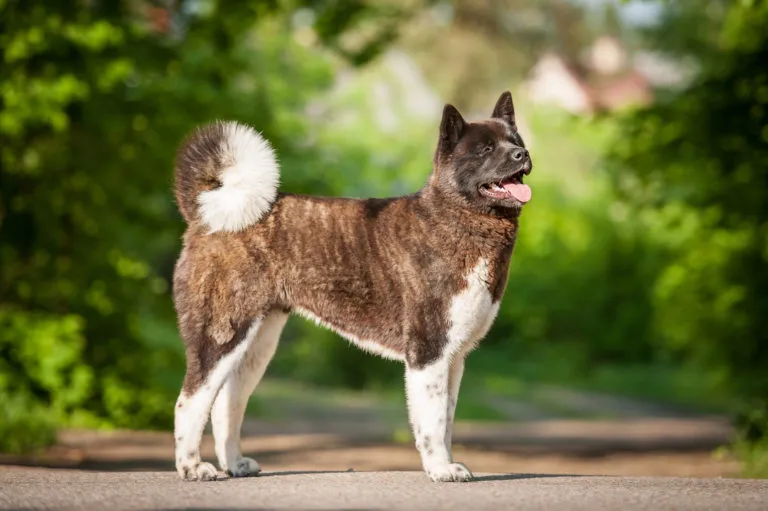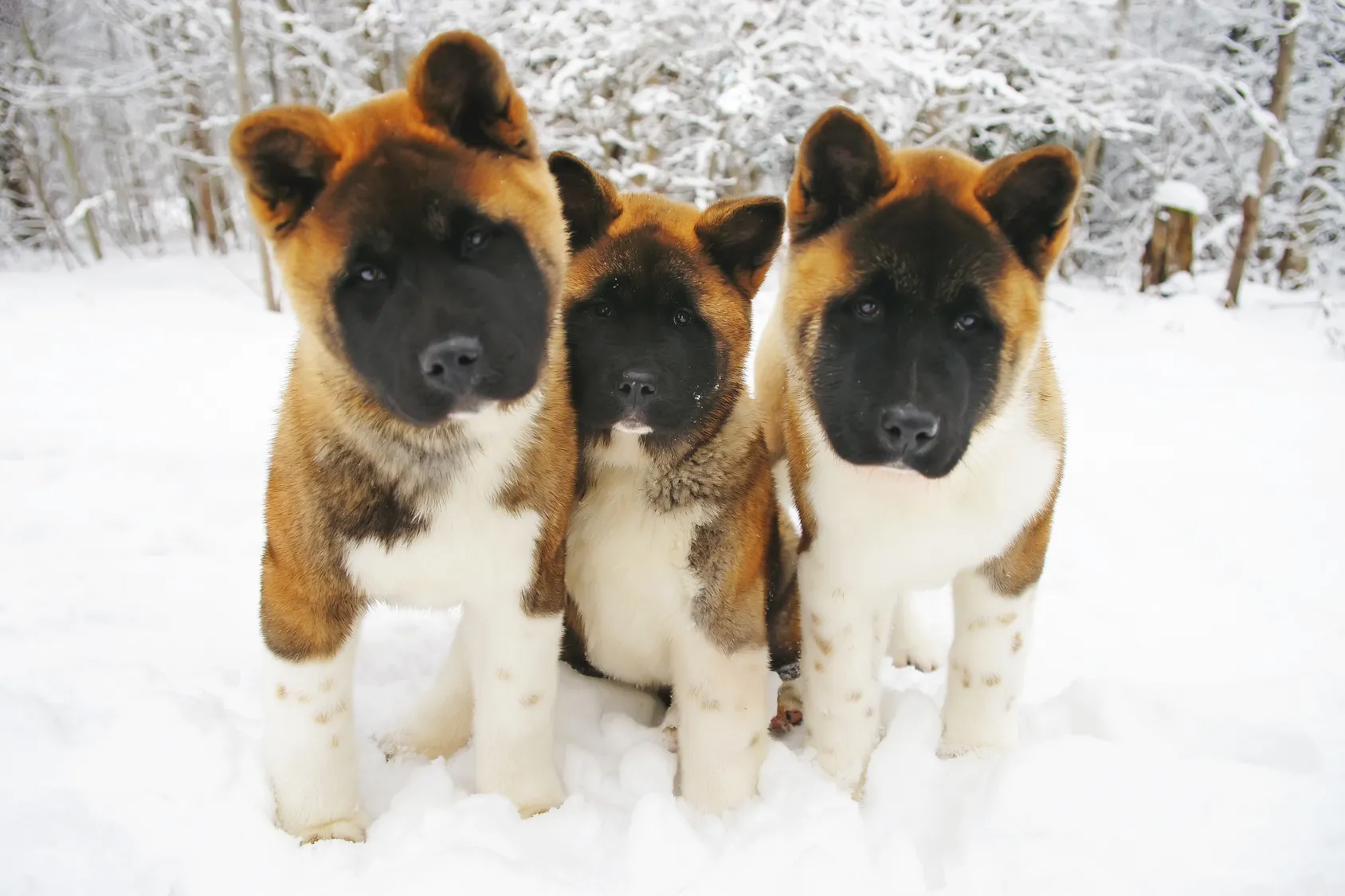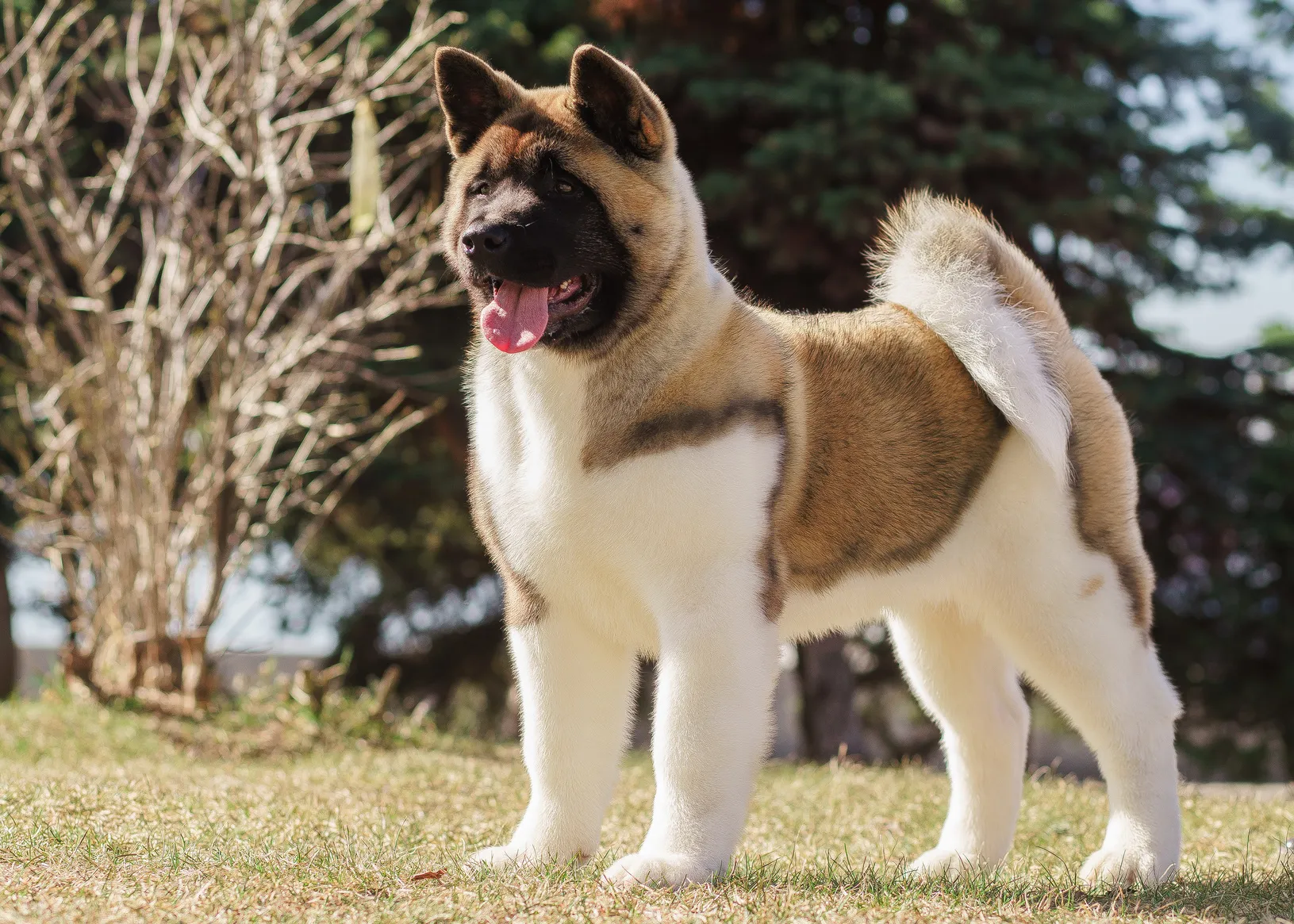Medium Size Poodle
The American Akita emerged after the end of the Second World War when US soldiers took Japanese Akitas back to the States with them, where an independent stand-alone breed was established. In comparison to its Japanese relatives, the American Akita is much bigger and stronger, though it has maintained to this day the hunting instinct of its Japanese ancestors.

© Grigorita Ko / stock.adobe.com
Fetching sticks and jumping through hoops? The American Akita is much too proud for such banal games. Numbered 344 in the FCI standard, these graceful pedigree dogs like there to be a sensible reason behind their tasks, so it requires some effort to motivate an Akita to cooperate. Although they are extremely sporty and capable of learning, their high intelligence and dominant tendencies don’t make training particularly easy.
Let it be said in advance that dog lovers with no experience of training and rearing dogs would be advised to plump for a somewhat more straightforward breed. The Akita belongs in the hands of experienced dog owners who enjoy a challenge. With corresponding training and early socialisation, the American Akita can be trained into a thoroughly loyal companion dog that loves its family more than anything, protects and guards them and that is capable of astonishing feats – not just in dog sports.
The American Akita needs a close connection to its family and should definitely not be kept alone in a kennel. As descendants of wolves, they like to have their “pack” around them, though their owner and possibly the children of the family are more than sufficient company for them. If they are accustomed to living with other pets from an early age, they can generally live with cats, hamsters, guinea pigs and co. without any problems, but the Akita does fundamentally remain a lone wolf that likes tranquility more than hustle and bustle.
American Akitas are reserved towards strangers, who they observe attentively from a distance, though they will not show aggressive behaviour. Although they are incredibly valiant and fearless as hunting dogs, these American pedigree dogs have a real bite inhibition towards humans – therefore the Akita is not very suitable for training as a guard dog. Once you have won the trust of this breed, you will find it very friendly and sensitive. Thus, intuition is the primary training requirement, along with the required consistency. Pressure or even violence soon lead to ignorance and stubbornness with these proud, sensitive dogs, which can not uncommonly result in insurmountable problems in living with humans.
Also called the Great Japanese Dog, the American Akita’s characteristic features are its wide, strong head shaped like a blunt triangle with forward-pointing triangular ears and a thick hairy tail that lies on the Akita’s back or rolled sideways. In relation to the head, the predominantly dark brown eyes are small and the snout is also deep-set.
In comparison to its close relative, the Japanese Akita Inu, the American Akita is significantly larger and heavier, with males reaching a height of 71cm and up to 55kg in weight. Females are also relatively powerful at a maximum height of 65cm and maximum weight of 40kg. This imposing appearance is reinforced by the thick guard coat with an abundant undercoat particularly thick and long on the tail, croup and withers (maximum 5cm). The American Akita can feature in a very diverse range of colours – including checked and blotched. Whilst white, red and brindle-coloured Akitas are preferred in Japan, pinto and black mask Akitas are particularly popular in the US. It should in principle be possible to clearly differentiate the distinct colour tones should there be more than one. Checked dogs mostly have large, evenly distributed markings that are set on a white base coat covering over a third of the entire body.
The Japanese and American Akitas were classed as one breed until the end of the Second World War, and their development up until this point in time is almost identical. Both originated in Japan, where they are connected by an almost 5,000 year history, as proved by depictions of dogs on clay pots and bronze bells. They were discovered in the Japanese region of Akita, where they were deployed for hunting bears, wild boars and fowl from the start of the 17th century. In the 19th century, the Akita took part in dog fights, which were then banned in Japan in 1908. In order to make fight dogs even bigger and more powerful, Tosas and Mastiffs were crossed at this time. One of the oldest in Asia, this large Japanese breed was declared a natural monument in 1931. It was forbidden for a long time to export them from Japan.
 © Eudyptula / stock.adobe.com
© Eudyptula / stock.adobe.com
Nevertheless, frequent crossing with other dog breeds meant that the Akita’s appearance had changed drastically by the early to mid-20th century, with numerous very distinct lines having formed. In order to bring some order to this chaos, the dogs were roughly assigned to two different blood lines: the Ichinoseki and the Dewa. The dogs that US soldiers took home with them at the end of the Second World War largely originated from the Dewa line.
In the subsequent years, a significant population of these large Japanese dogs grew up in the US. When the Akita Kennel Club (later renamed the Akita Club of America) was founded in 1956, targeted breeding commenced on American soil. However, Japan didn’t recognise the new American line and the American Kennel Club (AKC) also closed its stud book to Japanese imports in 1972. As a result of the lack of cooperation between the two countries, the Japanese and American breeds developed in very different ways. Although the AKC permitted breed imports from Japan once again from 1992, the difference between the delicate Japanese and powerful American Akitas had by then become so great that it was almost impossible to still speak of the same breed.
In 2000, the Fédération Cynologique Internationale (FCI) therefore decided to split the breed into the Japanese Akita (standard number 255) and the Great Japanese Dog (American Akita, standard number 344). The first standard published by the American Kennel Club in 1972 for the American Akita was the basis for the new FCI standard.
There are now breeders of both the American and Japanese lines in Europe. Maintaining the typical characteristics of each breed is at the forefront of today’s breeding endeavours, but the health and stability of the breed is also the utmost priority with breeders. Strict breeding regulations and the commitment of many breeders can be thanked for the robustness of the American Akita, which has no breed-specific diseases. It generally isn’t particularly susceptible to other typical diseases affecting dogs either. Skin and hair diseases could be classed as the most problematic factor, along with hip ailments (HD).
Diet is the cause of skin and hair diseases. For instance, an excessive amount of crude protein (found in so-called energy or high-performance food) can lead to huge allergic reactions affecting the skin. Grain and soy products can also cause Akitas problems with their skin and fur. When buying ready-made dog food, you should definitely take into account the ingredients list on the packaging. If the food contains too much grain or even soy, you would be better off choosing a different product.
Aside from possible allergies, the American Akita has the same demands as all other dogs when it comes to food. As direct descendants of wolves, they are carnivores and their food should be based on a high-quality source of animal protein in the form of meat (or fish too). You would be best off avoiding pork though due to the tendency to develop allergies described previously. Beef, lamb, game or ostrich are recommended and can be supplemented with vegetables and rice. Whether this is served in the form of kibbles or wet dog food, raw or freshly cooked ultimately depends not just on your dog’s taste, but also on the owner’s conviction. Whilst some dog owners prefer quick all-round provision with a conventional dog food, others swear by fresh, self-made foodstuffs, the composition and preparation of which requires time and expertise.
Regardless of what method you ultimately choose, it’s important that your dog has fresh drinking water available at all times. In contrast, it should only be fed at fixed mealtimes (twice a day for adult dogs), and the food should be cleared away at the latest 20 minutes later – never mind if there is anything left in the food bowl. Generally, Akitas need very little food in relation to their size. You should regularly monitor your dog’s weight in order to establish the right amount of food.
You should groom your Akita as frequently as you monitor its weight. Thanks to its thick, short and self-cleaning fur, the time commitment is thankfully manageable. It’s sufficient to brush the fur once to twice a week so that you maintain its shine and can recognise at an early stage possible skin irritations triggered by an incorrect diet. During the moulting period (twice annually), you should brush your dog every day. By brushing out the old, dead hairs, you make the moulting period easier for your dog and also reduce the amount of hair that can spread across your home during this phase.
Even when grooming and diet are relatively straightforward when it comes to American Akitas, you shouldn’t underestimate the demands of owning one. They need a lot of exercise in order to keep fit, even if they do not always demand it. Two quick trips around the block are definitely not sufficient for these dogs. A complicating factor is that they are only suitable for dog sports to a limited extent. Although these large Japanese dogs are by nature very sporty, they are proud and independent and have no patience for little mobility games. Only if you manage to make your dog see the sense of sport will you be able to motivate it to attend a dog sports school. An American Akita Inu could cost between £800 and £1,300.
 © Елена Насекина / stock.adobe.com
© Елена Насекина / stock.adobe.com
Along with their stubbornness, a further challenge is the still-prevalent hunting instinct, which can have undesired consequences with shared activities. The Akita should only be taken out on its lead in and on the edge of woods. In order for this to succeed and the powerful dog not to end up taking you for a walk, you should work on lead behaviour in training from an early stage. In general, loving but consistent training and comprehensive socialisation as a puppy for life together with an adult Akita are of huge importance. If you are considering purchasing an Akita, you should absolutely have sufficient experience in training and rearing dogs. If you do possess this knowledge and go along with the peculiarities of the proud and independent character, the Akita will be an unbelievably loyal and graceful partner that sticks by its family through thick and thin.
Here are some purchase proposals curated by the zooplus editorial team
The products featured have been carefully selected by our editorial staff and are available at the zooplus online pet shop. The selection does not constitute advertising for the mentioned brands.
Fans of the Bearded Collie agree that those who aren't familiar with this dog breed simply have to get acquainted with it. And those who have experienced how a Bearded Collie bolts across meadows with its flowing fur, how it rolls around full of energy and joy and how it attentively and observantly takes into account its owners wishes become simply addicted to this original dog breed and its unique charm.
The Goldendoodle isn't a breed, but a pairing between Golden Retrievers and Medium or Standard Poodles. Marketed as a low-maintenance dog for allergy sufferers, this hybrid is enjoying increasing popularity amongst dog lovers, similar to the Labradoodle.